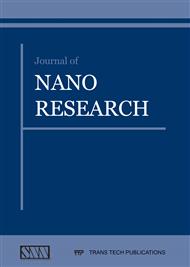[1]
Q. Wang, China's citizens must act to save the environment, Nature 497 7448 (2013) 159.
DOI: 10.1038/497159a
Google Scholar
[2]
C. A. Pope III, R. T. Burnett, M. J. Thun, E. E. Calle, D. Krewski, K. Ito and G. D. Thurston, Lung cancer, cardiopulmonary mortality, and long-term exposure to fine particulate air pollution, JAMA 287 9 (2002) 1132.
DOI: 10.1001/jama.287.9.1132
Google Scholar
[3]
P. Dadvand, J. Parker, M. L. Bell, M. Bonzini, M. Brauer, L. A. Darrow, U. Gehring, S. V. Glinianaia, N. Gouveia and E. Ha, Maternal exposure to particulate air pollution and tern birth weight: a multi-country evaluation of effect and heterogeneity, Environ. Health Persp. 121 3 (2013).
DOI: 10.1097/01.ede.0000416765.64481.0d
Google Scholar
[4]
J. Wang, Y. Lei, J. Yang and G. Yan, China's air pollution control calls for sustainable strategy for the use of coal, Environ. Sci. Technol. 46 8 (2012) 4263.
DOI: 10.1021/es301226n
Google Scholar
[5]
L. Huang, S. S. Manickam, J. R. McCutcheon, Increasing strength of electrospun nanofiber membranes for water filtration using solvent vapor, J. Membr. Sci. 436 1 (2013) 213.
DOI: 10.1016/j.memsci.2012.12.037
Google Scholar
[6]
J. Li, F. Gao, L. Liu and Z. Zhang, Needleless electro-spun nanofibers used for filtration of small particles, eXPRESS Polymer Letter 7 8 (2013) 683.
DOI: 10.3144/expresspolymlett.2013.65
Google Scholar
[7]
L. Jing, K. Shim, C. Y. Toe, T. Fang, C. Zhao, R. Amal, K. -N. Sun, J. H. Kim, and Y. H. Ng, Electrospun Polyacrylonitrile-Ionic Liquid Nanofibers for Superior PM2. 5 Capture Capacity, ACS Appl. Mater. Interface 8 (2016) 7030.
DOI: 10.1021/acsami.5b12313
Google Scholar
[8]
Y. Wang, G. Zhuang, A. Tang, H. Yuan, Y. Sun, S. Chen and A. Zheng, The ion chemistry and the source of PM2. 5 aerosol in Beijing, Atmos. Environ. 39 21 (2005) 3771.
DOI: 10.1016/j.atmosenv.2005.03.013
Google Scholar
[9]
C. Liu, P. -C. Hsu, H. -W. Lee, M. Ye, G. Zheng, N. Liu, W. Li, and Y. Cui, Transparent air filter for high-efficiency PM2. 5 capture, Nat. Comm. 6 6205 (2015) 1.
DOI: 10.1038/ncomms7205
Google Scholar
[10]
E. Zussman, X. Chen, W. Ding, L. Calabri, D. A. Dikin, J. P. Quintana, R. S. Ruoff, Mechanical and structural characterization of electrospun PAN-derived carbon nanofibers, carbon 43 10 (2005) 2175.
DOI: 10.1016/j.carbon.2005.03.031
Google Scholar
[11]
S. F. Fennessey, R. J. Farris, Fabrication of aligned and molecularly oriented electrospun polyacrylonitrile nanofibers and the mechanical behavior of their twisted yarns, Polymer, 45 12 (2004) 4217.
DOI: 10.1016/j.polymer.2004.04.001
Google Scholar
[12]
R. Luoh, and H. T. Hahn, Electrospun nanocomposite fiber mats as gas sensors, Compos. Sci. Technol. 66 14 (2006) 2436.
DOI: 10.1016/j.compscitech.2006.03.012
Google Scholar
[13]
Q. Zhang, J. Welch, H. Park, C. Wu, W. Sigmund, and J. C. Marijinissen, Improvement in nanofiber filtration by multiple thin layer of nanofiber mats, J. Aero. Sci. 41 2 (2010) 230.
DOI: 10.1016/j.jaerosci.2009.10.001
Google Scholar
[14]
K. M. Yun, C. J. Hogan, Y. Matsubayashi, M. Kawabe, F. Iskandar, K. Okuyama, Nanoparticle filtration by electrospun polymer fibers, Chem. Eng. Sci. 62 (2007) 4751.
DOI: 10.1016/j.ces.2007.06.007
Google Scholar
[15]
Z. –M. Huang, Y. Z. Zhang, M. Kotaki, S. Ramakrishna, A Review on Polymer Nanofibers by Electrospinning and Their Applications in Nanocomposites, Composit. Sci. Tech. 63 (2003) 2223.
DOI: 10.1016/s0266-3538(03)00178-7
Google Scholar
[16]
J. Li, S. Su, L. Zhou, V. Kundrat, A. M. Abbot, F. Mushtaq, D. Ouyang, D. James, D. Roberts and H. Ye, Carbon nanowalls grown by microwave plasma enhanced chemical vapor deposition during the carbonization of polyacrylonitrile fibers, J. Appl. Phys. 113 2 (2013).
DOI: 10.1063/1.4774218
Google Scholar
[17]
T. –H. Ko, The influence of pyrolysis on physical properties and microstructure of modified PAN fibers during carbonization, J. Appl. Poly. Sci., 43 (1991) 589.
DOI: 10.1002/app.1991.070430321
Google Scholar
[18]
Handbook of Carbon, Graphite, Diamond and Fullerenes, Edited by H. O. Pierson, William Andrew Publishing, Oxford, (1993).
Google Scholar
[19]
PhD. Thesis, Jiangling Li, Aston University, (2014).
Google Scholar
[20]
Nanodiamonds: Applications in Biology and Nanoscale Medicine, Edited by Dean Ho, Springer Publisher, New York, (2009).
Google Scholar
[21]
Electrospun Nanofibers for Energy and Environmental Applications, Edited by B. Ding and J. Yu, Springer Berlin Heidelberg, (2014).
Google Scholar
[22]
J. Li, S. Su, L. Zhou, A .M. Abbot and H. Ye, Dielectric transition of polyacrylonitrile derived carbon nanofibers, Mater. Res. Exp. 1 3 (2014) 035604.
DOI: 10.1088/2053-1591/1/3/035604
Google Scholar
[23]
H. Goeminne, G. Van der Perre, T. Hens, and J. Van Der Planken, Formation and growth of cu3uii in a deformed matrix, Acta Metallurgica, 22 6 (1974) 725.
DOI: 10.1016/0001-6160(74)90082-0
Google Scholar
[24]
X. W. Li, H. Y. Kong, and J. H. He, Study on highly filtration efficiency of electrospun polyvinyl alcohol micro-porous webs, Indian. J. Phys. 89 2 (2015) 175.
DOI: 10.1007/s12648-014-0542-2
Google Scholar



